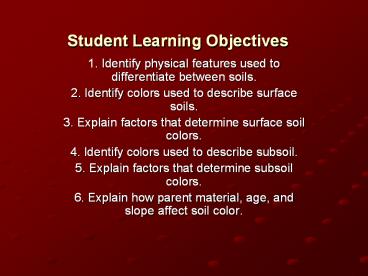Student Learning Objectives PowerPoint PPT Presentation
Title: Student Learning Objectives
1
Student Learning Objectives
- 1. Identify physical features used to
differentiate between soils. - 2. Identify colors used to describe surface
soils. - 3. Explain factors that determine surface soil
colors. - 4. Identify colors used to describe subsoil.
- 5. Explain factors that determine subsoil colors.
- 6. Explain how parent material, age, and slope
affect soil color.
2
Terms.
- Bright-colored
- Color
- Deciduous hardwood forest
- Dull-colored
- Humus
- Mottle-colored
- Native vegetation
- Structure
- Tall prairie grass
- Texture
3
What are physical features used to differentiate
between soils?
- Soils have many features that are used to
recognize differences between them. They include - A. Texturecoarseness or fineness of soil
particles - B. Structurethe way in which soil particles are
held together - C. Depth of horizonsthe depth of each soil
- D. Colorrefers to the darkness or lightness of
the soil color
4
What are the colors used to describe surface
soils?
- Very darkapproximately 5 organic matter
- Darkapproximately 3.5 organic matter
- Moderately darkapproximately 2.5 organic matter
- Lightapproximately 2 organic matter
- Very lightapproximately 1.5 organic matter
5
What factors determine the color of surface soils?
- The amount of organic matter is the factor used
to determine the color of the surface soil. - The amount of organic matter is determined by the
kind of native vegetation. - Native vegetation refers to the type of plant
material that grew on the soil.
6
What factors determine the color of surface soils?
- Deciduous hardwood forests a shallow layer of
partially decayed leaves, twigs, and fallen logs
accumulated on the surface. Because they were on
the surface, they decayed more rapidly than those
of the prairie grass. This left only a thin,
moderately dark top layer. As these soils have
been worked, they have been mixed with the
lighter soil underneath to produce a lighter
color.
7
What colors are used to describe subsoil?
- Subsoil colors are associated with natural
drainage of the soils. This is the drainage
condition that existed when the soil was forming.
Subsoil colors are classified as - A. Bright-coloredbrown, reddish brown, or
yellowish brown - B. Dull-coloredgray or olive gray
- C. Mottle-coloredclumps of both bright and dull
colors mixed together
8
What factors determine the color of subsoil?
- The color of subsoil is determined by the status
of iron compounds. These are determined by - the type of drainage found in the soil as it
formed. - A. Good drainage provides subsoil that is bright
in color. This is because the iron found in - these soils has been oxidized. This can be
compared to metal that oxidizes or rusts when - both moisture and air are present. Rust has a
bright or orange color.
9
What factors determine the color of subsoil?
- Poor drainage provides subsoil that is dull or
gray in color. This is because the iron found in
those soils has not been subject to air or
oxygen. The iron compounds do not oxidize. - This leaves a grayish color.
10
What factors determine the color of subsoil?
- Somewhat poor drainage provides sub soils that
are mottled. - This is because the soil was saturated with
moisture for certain periods. This leaves a gray
color in some soil clumps. - Since the soil was comparatively dry during other
periods, it left a bright color in other soil
clumps.
11
How do parent material, age, and slope affect the
color of soil?
- Parent material. The color of a soil is
associated with the kind of material from which
it is formed. - Soils that are developed from sand or
light-colored rock will be lighter. - Those developed from darker materials such as
peat or muck, will be darker in color.
12
How do parent material, age, and slope affect the
color of soil?
- Age. Some soils can be younger than others. As
soils age, much of the darker color is lost due
to the weathering process. - This causes the soil to lose organic matter.
13
How do parent material, age, and slope affect the
color of soil?
- Slope. Soil on top of hills is usually lighter in
color than the soil in depressions or on level
ground. - This is partly due to the darker topsoil being
washed off the hills. This leaves the lighter
subsurface or subsoil exposed. Also, there tends
to be moisture on lower land. - This allows more abundant growth of plants in the
lower areas, which in turn provides more organic
matter and a darker color to lower soils.
14
(No Transcript)
15
(No Transcript)

